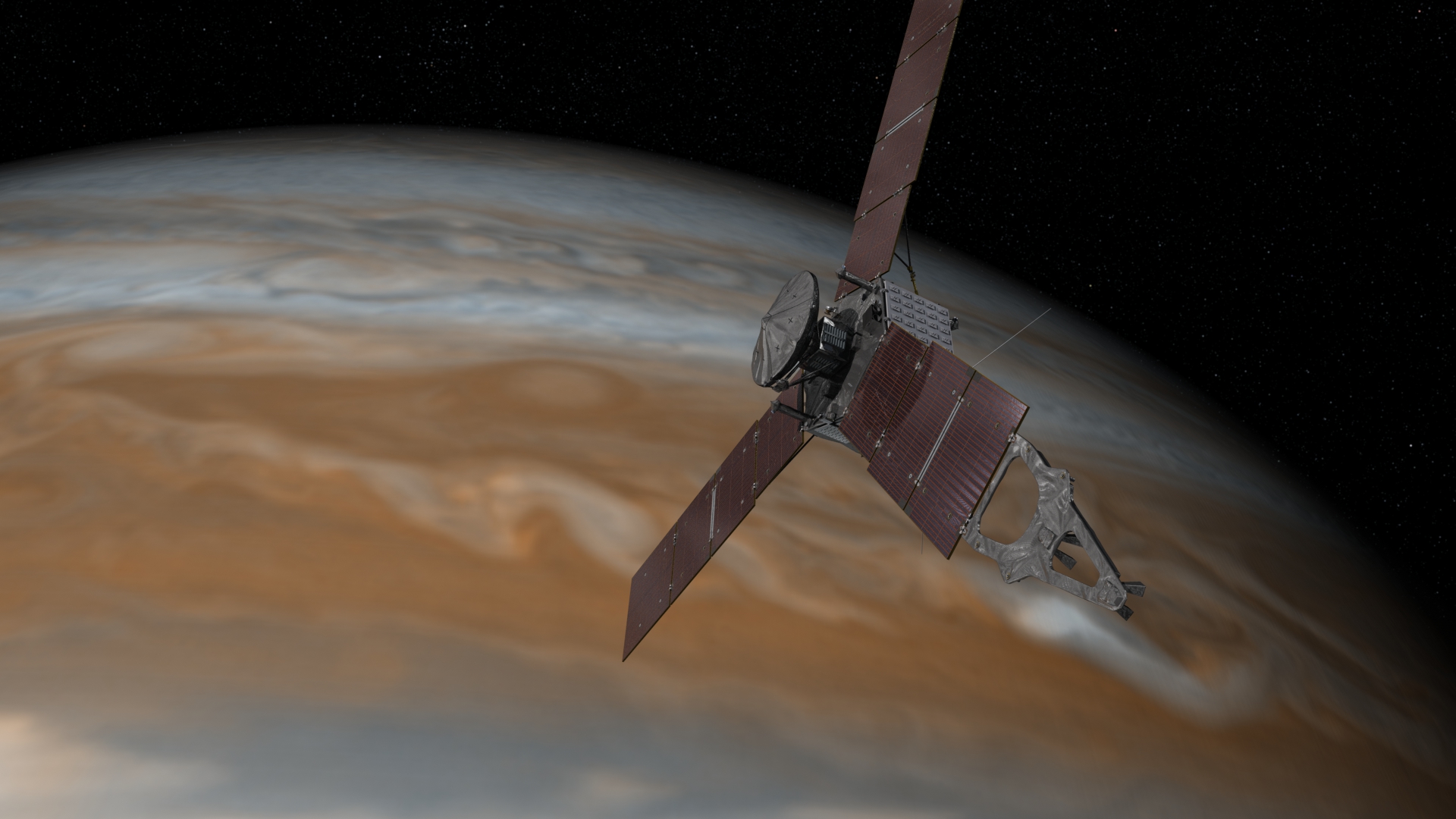After accident on Mars, NASA's Ingenuity helicopter could live on as a weather station for 20 years
"She still has one final gift for us, which is that she's now going to continue on as a weather station of sorts."

Ingenuity may be down, but it's not out.
Scientists at NASA's Jet Propulsion Laboratory (JPL) gave an update on the downed Ingenuity Mars helicopter on Wednesday (Dec. 11) during the 2024 Annual Meeting of the American Geophysical Union (AGU) in Washington, D.C. After traveling to Mars attached to the Perseverance rover, Ingenuity began a test flight campaign to prove that powered flight in the thin Martian atmosphere was possible. After almost three years of operating on the Red Planet, Ingenuity crashed during its 72nd flight on Jan. 18, 2024, suffering rotor damage that rendered it incapable of ever flying again.
But after conducting the "first aircraft investigation on another world," Ingenuity's mission managers at JPL say the helicopter could have a second life on the Red Planet. "We are very proud to report that, even after the hard landing in flight, 72 avionics battery sensors have all been functional, and she still has one final gift for us, which is that she's now going to continue on as a weather station of sorts, recording telemetry, taking images every single sol and storing them on board," said Teddy Tzanetos, Ingenuity's project manager at JPL, during the team's presentation at AGU.
JPL has spent months investigating Ingenuity's crash, and determined that the helicopter's navigation systems had too little information to go with due to the monotone, bland texture of the Martian surface.
"This does not mean that we've been able to figure out everything about the flight," said Ingenuity’s first pilot, JPL's Håvard Grip, at today's presentation at AGU 2024. "Our conclusion is that we don't have enough information to disentangle some of the details about the sequence of events right around landing."
Grip added that, while the team's investigation is over, it is far from complete due to the vast distance between JPL and Ingenuity's final resting place.
"One of the things that makes it difficult to investigate this is the relative lack of information," he said. "The accident site itself is about, you know — it's more than 100 million miles [160 million kilometers] away. There's no black box, there are no eyewitnesses. We can't walk up and touch anything, so we have to work with the small pieces of information that we have."
Get the Space.com Newsletter
Breaking space news, the latest updates on rocket launches, skywatching events and more!

However, JPL scientists added that, aside from its mission-ending rotor damage, Ingenuity remains in otherwise good health. In fact, if you were to ask the helicopter itself, Ingenuity would report that everything is fine, Tzanetos said.
"If you were to query Ingenuity's health system, she's green across the board as far as she's concerned. She doesn't have a sensor on the rotor system to detect the damage. But we are very proud to report that, even after the hard landing on flight 72, avionics, battery, [and] sensors have all been functional."
Tzanetos added that Ingenuity has around 20 years' worth of onboard storage remaining, meaning it can keep taking measurements and images every Martian sol (a solar day on Mars).
But there may be no way to get that data back to Earth. The Perseverance rover, through which Ingenuity communicates via radio link in order to send its data back to its mission team, is now 1.8 miles (3 km) away from the helicopter. Soon, Ingenuity might lose its ability to communicate with its human controllers on Earth.
"I think it's a good bet that, within the next month, we'll lose contact forever, or until we come back in 20 years with astronauts, or until we turn back for sample return," Tzanetos said during the presentation at AGU.
Despite its crash, Ingenuity proved to be wildly successful. The helicopter was designed to make only five flights on Mars, and ended up making 72. Because it was only a flight demonstrator, the helicopter was not designed to carry science instruments.
But JPL is already looking to the future of powered flight on Mars. During today's presentation at AGU, JPL scientists presented a video of a new Red Planet helicopter concept known as Mars Chopper.
The design is still conceptual and does not have a timeline for reaching Mars, but JPL is envisioning a six-rotor concept that is 20 times heavier than Ingenuity and could carry "several pounds of science equipment and autonomously explore remote Martian locations while traveling up to 2 miles (3 kilometers) in a day," according to a JPL statement.
Join our Space Forums to keep talking space on the latest missions, night sky and more! And if you have a news tip, correction or comment, let us know at: community@space.com.

Brett is curious about emerging aerospace technologies, alternative launch concepts, military space developments and uncrewed aircraft systems. Brett's work has appeared on Scientific American, The War Zone, Popular Science, the History Channel, Science Discovery and more. Brett has English degrees from Clemson University and the University of North Carolina at Charlotte. In his free time, Brett enjoys skywatching throughout the dark skies of the Appalachian mountains.
-
Stpooch I mean , when I saw that ingenuity rotor and blades at first time they showed it to public I knew right away it's gonna be a problem ahead. You just can't ignore strong UV and cosmic ray radiations, heat and coldness., etc . That gizmo seems was not well protected from the get go. It's well known fact that carbon fiber composite and resin are so weak to prolong exposure to UV rays. Even on Earth . Well, next time, and this time make sure to ask advices from public too. Especially , to an Originator who really came up on that stunning idea.Reply -
kevincap44 Reply
was a proof of concept of flight only. meaning if it fly's it workedStpooch said:I mean , when I saw that ingenuity rotor and blades at first time they showed it to public I knew right away it's gonna be a problem ahead. You just can't ignore strong UV and cosmic ray radiations, heat and coldness., etc . That gizmo seems was not well protected from the get go. It's well known fact that carbon fiber composite and resin are so weak to prolong exposure to UV rays. Even on Earth . Well, next time, and this time make sure to ask advices from public too. Especially , to an Originator who really came up on that stunning idea. -
24launch ReplyStpooch said:I mean , when I saw that ingenuity rotor and blades at first time they showed it to public I knew right away it's gonna be a problem ahead. You just can't ignore strong UV and cosmic ray radiations, heat and coldness., etc . That gizmo seems was not well protected from the get go. It's well known fact that carbon fiber composite and resin are so weak to prolong exposure to UV rays. Even on Earth . Well, next time, and this time make sure to ask advices from public too. Especially , to an Originator who really came up on that stunning idea.
You'd be surprised at the genius engineers who work for NASA and especially at JPL. The general "public" would have little additional knowledge and experience to offer them. ;)
Keep in mind this was an almost after-thought technology demonstration constrained by extreme monetary, time and mass budgets. They hoped AT BEST it would last at least 5 flights over the course of a single month on the insanely harsh surface of Mars. Additionally, Mars' atmosphere is nearly non-existent. So the blades are HUGE compared to what would be needed on Earth. Additionally they spun between 2400 and 2900 RPM, which is again 10X the speed that would be needed on Earth. They honestly didn't know if it would be able to fly at all, which is why they didn't sink a ton more money in it - money that wasn't in the mission budget.
Shocking everyone it worked! And it lasted for 72 flights, and after 3 years IT'S STILL operating! Albeit it can no longer fly. If you were to look up "Overwhelmingly successful flying technology demonstration on another planet" in the dictionary you would find "The NASA Ingenuity Mars Helicopter.
If you read the article the only reason the blades were damaged was because they impacted the surface when the on-board navigation system was unable to determine the altitude of the craft due to the bland, steep, relatively featureless sand ripples in that particular region of Jezero Crater.
Unfortunately this article is missing some of the details from the source press release.
In short, the helicopter's on-board navigation sensors were unable to discern enough features in the relatively smooth surface of Mars to determine its position, so when it touched down, it did so moving horizontally. This caused the vehicle to tumble, snapping off all four of the helicopter's blades.
This technology demonstration was wildly successful proving that we (rather, the geniuses at NASA JPL) have the knowledge and skills to build flying machines that can think and navigate autonomously on other worlds! This is insane! They're already drawing up plans for much bigger, future craft for Mars and even more excitedly are moving forward with building a car-size rotorcraft to fly on Saturn's moon Titan due to launch in 2028 on a SpaceX Falcon Heavy and arrive at Titan in 2034. SPACEcom recently had an article when NASA selected SpaceX to launch it and there have been previous articles here about the mission. -
Jthawort Why are we throwing so much junk at Mars? To search for ancient water? Hardly worth polluting the planet with abandoned equipment. We’re not looking for landing sites because we aren’t going there for decades. Spend the money on exploration of the other planets, especially Neptune and Uranus which we know very little about.Reply -
Rob77 Reply
I think Mars is a good test ground for interplanetary exploration. Its close enough to send craft / equipment in a relatively short time frame. While I agree there may be risk of contamination from science equipment left over from previous missions, i'm sure the engineers / science teams will do everything they can to mitigate that risk.Jthawort said:Why are we throwing so much junk at Mars? To search for ancient water? Hardly worth polluting the planet with abandoned equipment. We’re not looking for landing sites because we aren’t going there for decades. Spend the money on exploration of the other planets, especially Neptune and Uranus which we know very little about.
If we were to just focus on missions to the outer solar system - the time frame of the missions would span decades. I think the focus on the moons of Jupiter & Saturn are interesting and close enough to achieve results within a decade.









